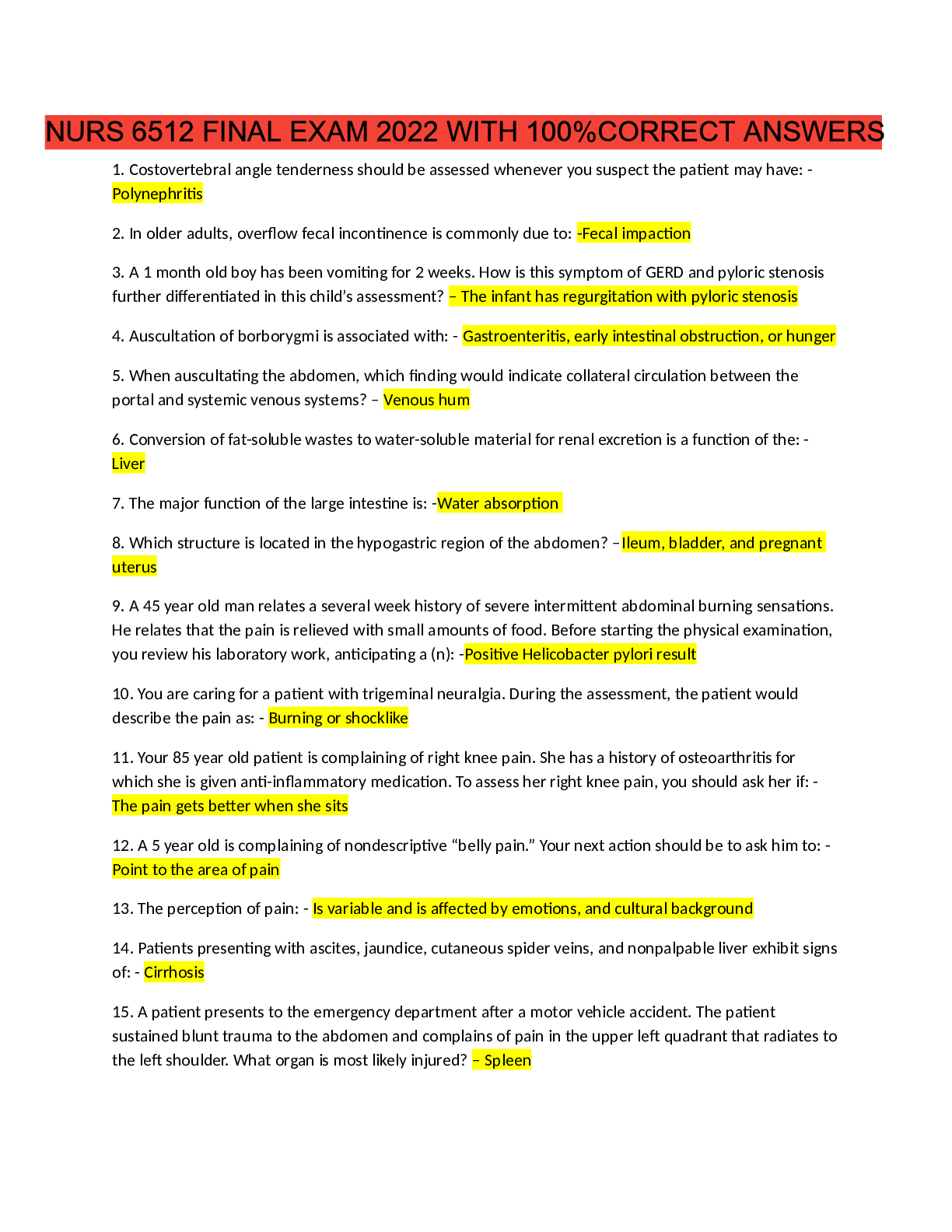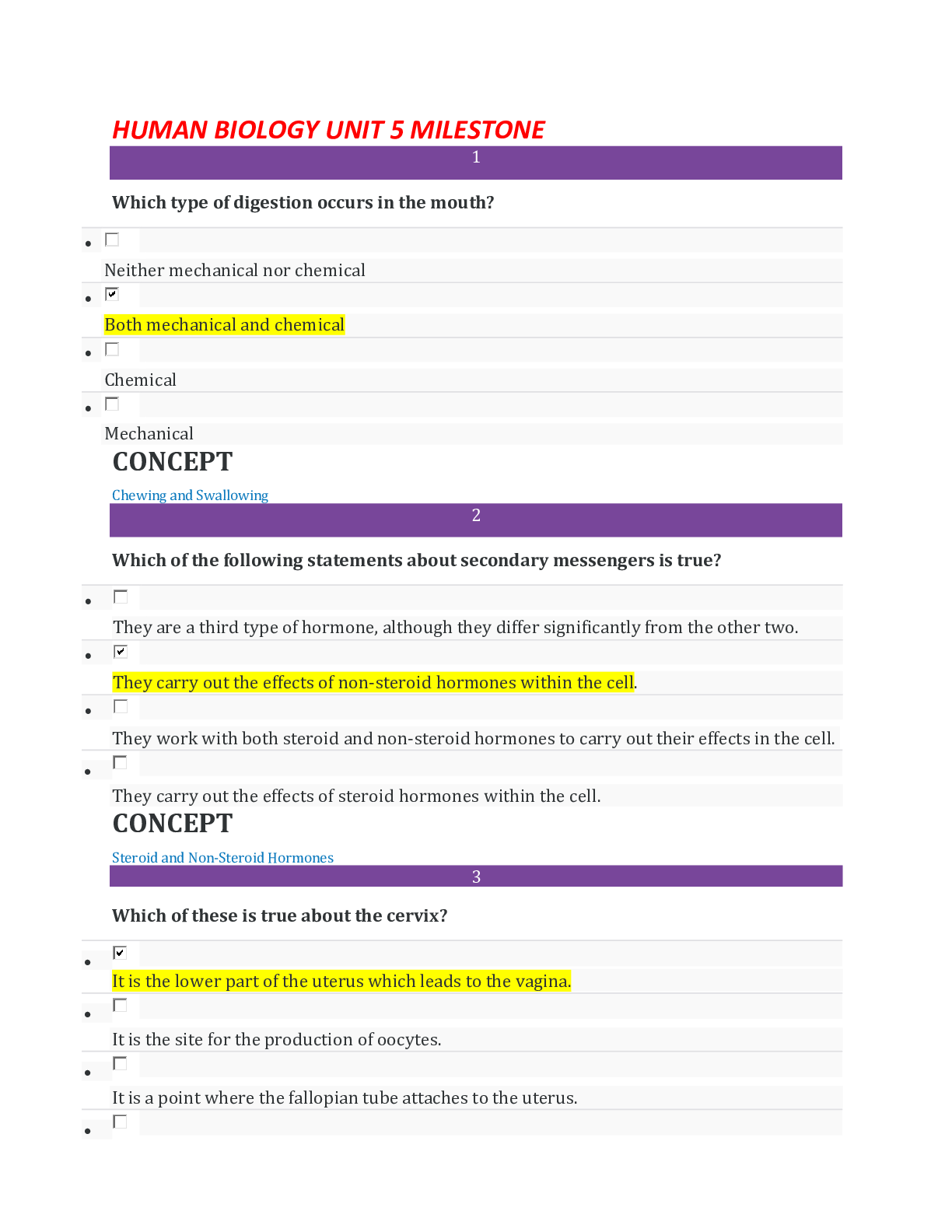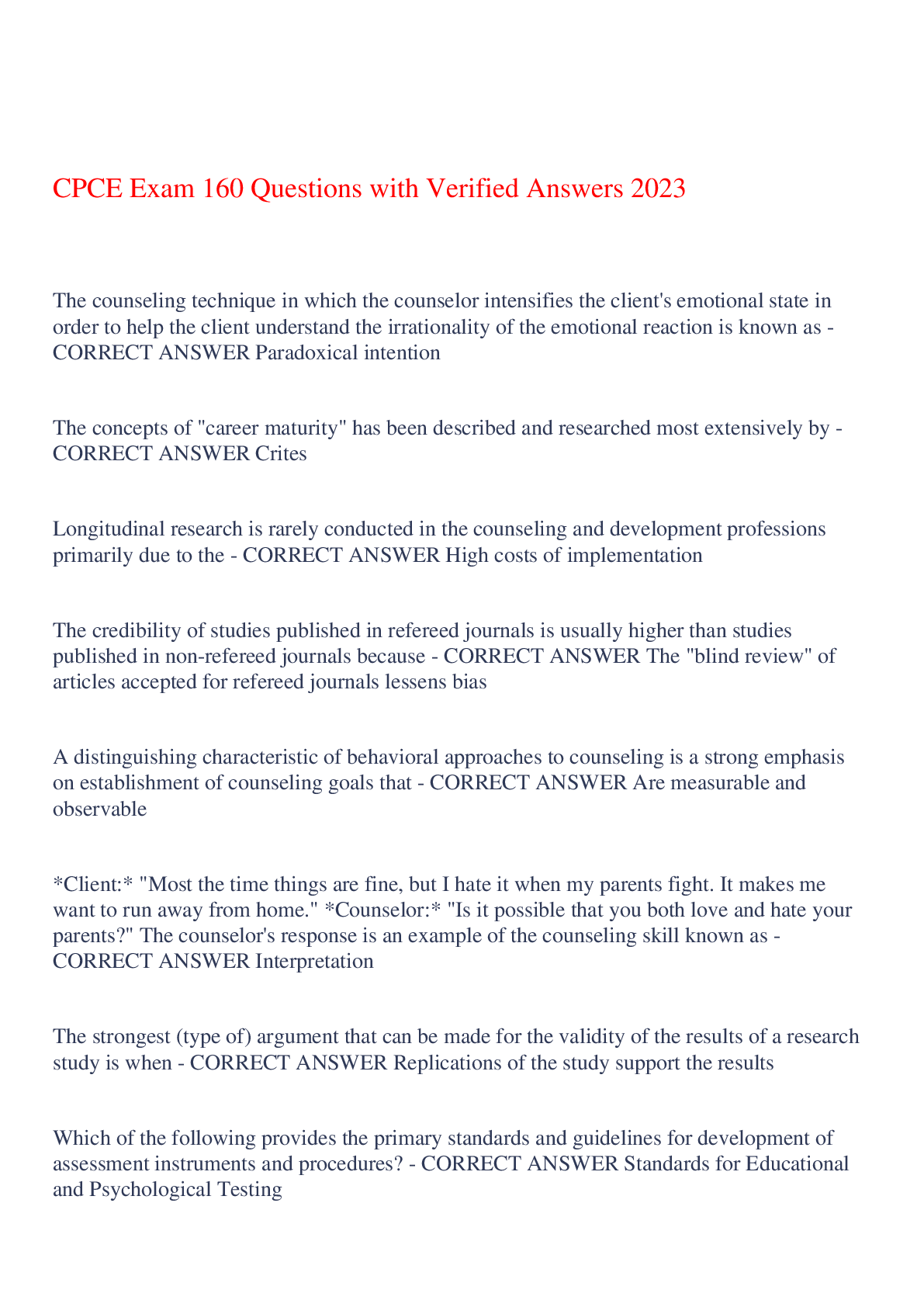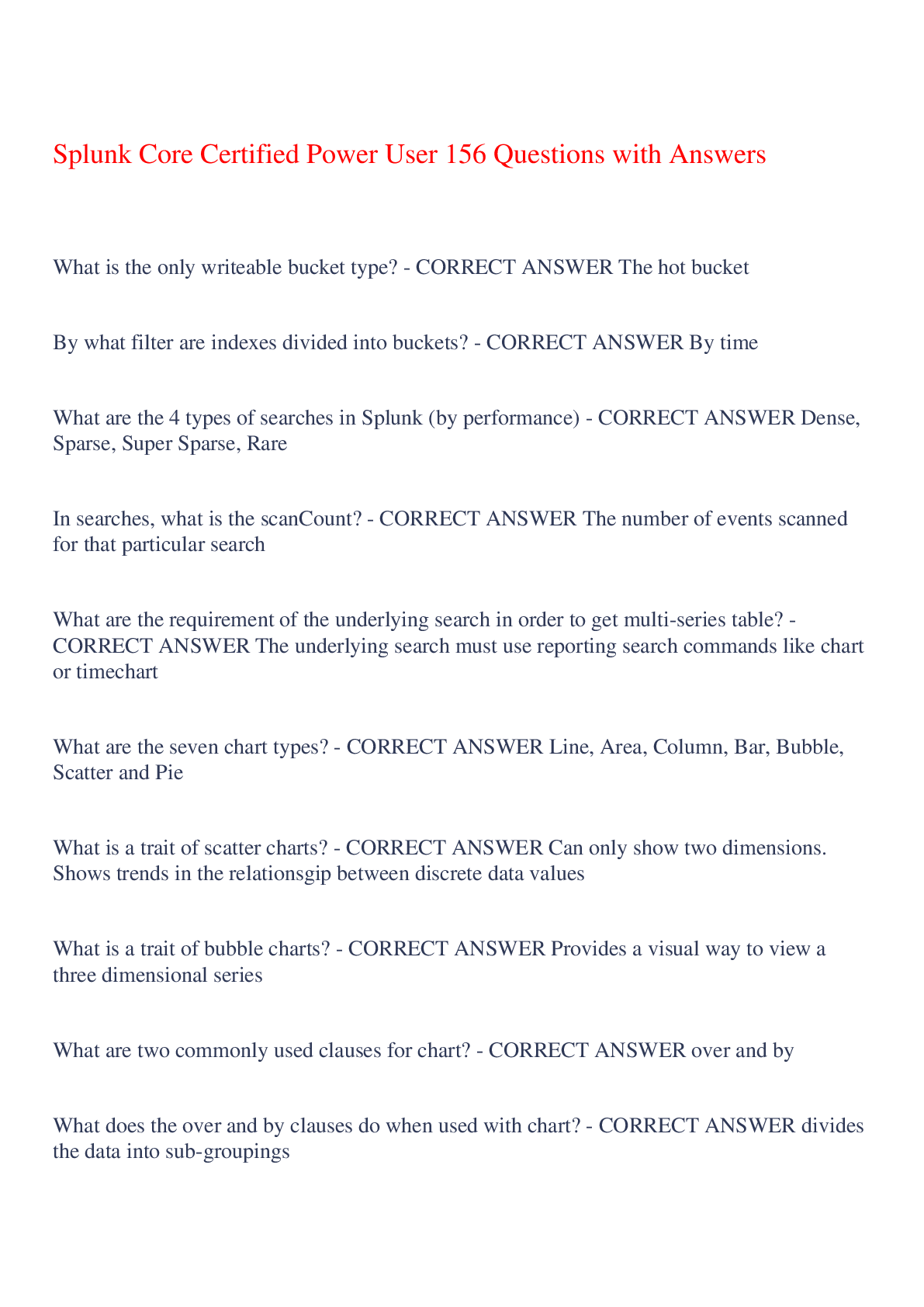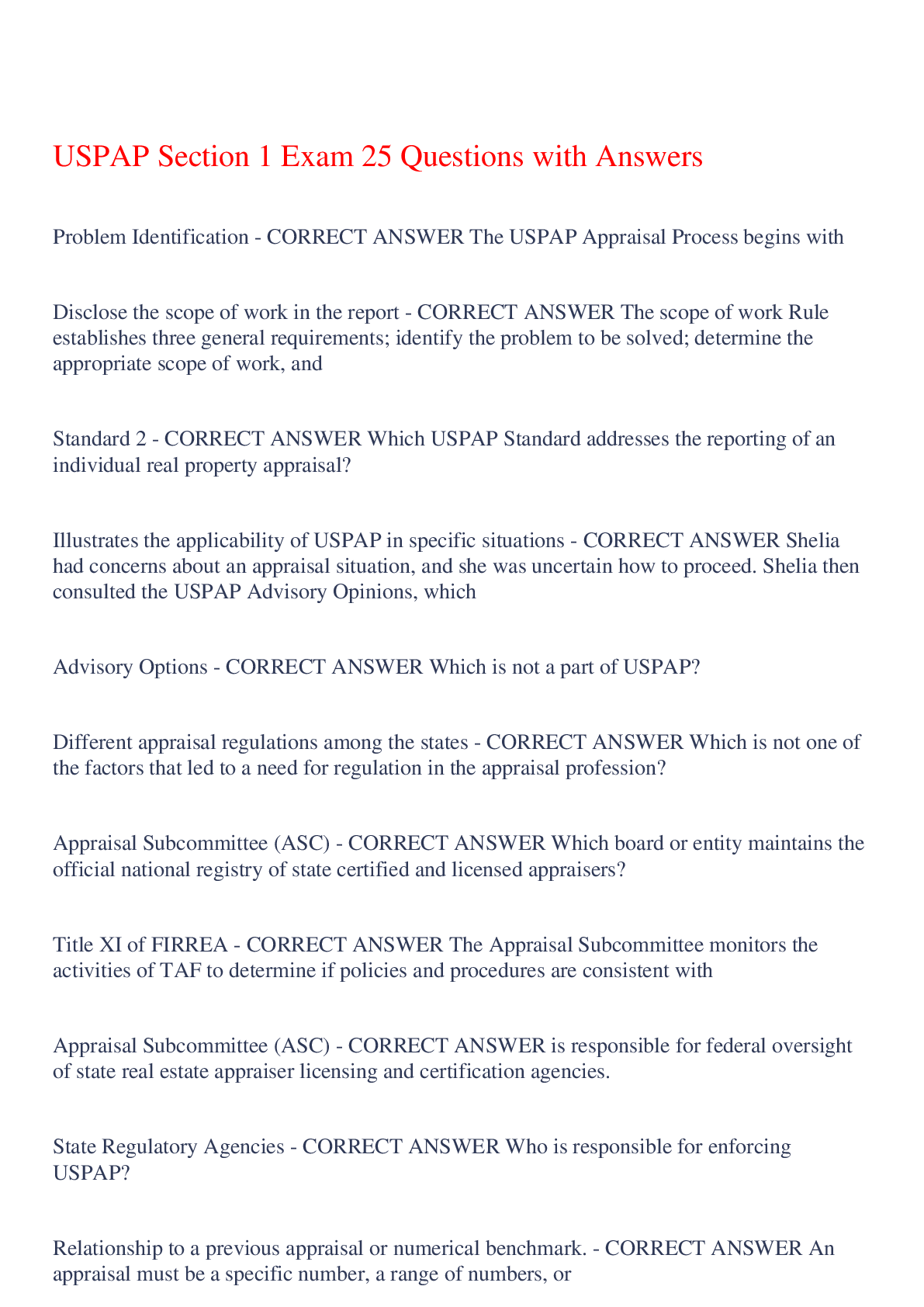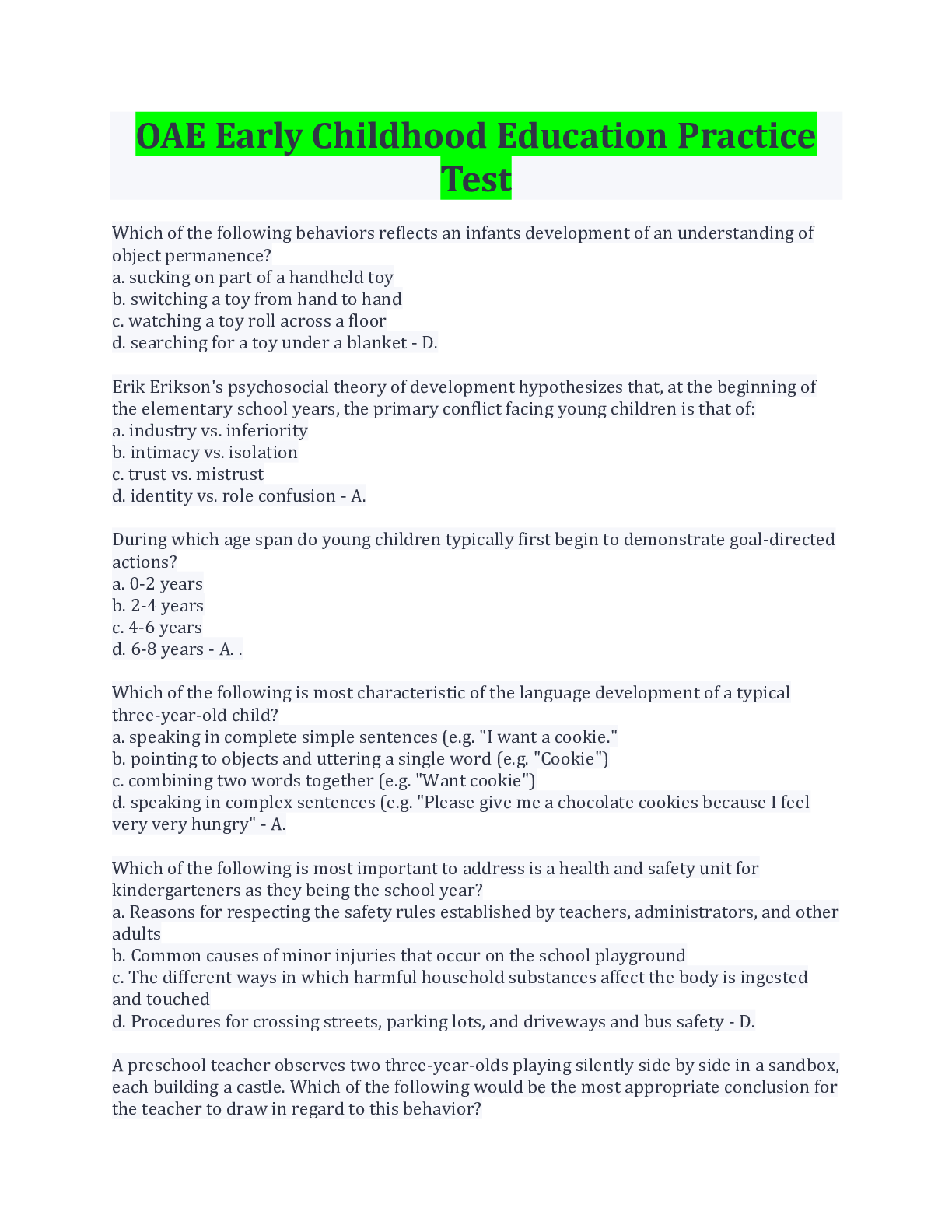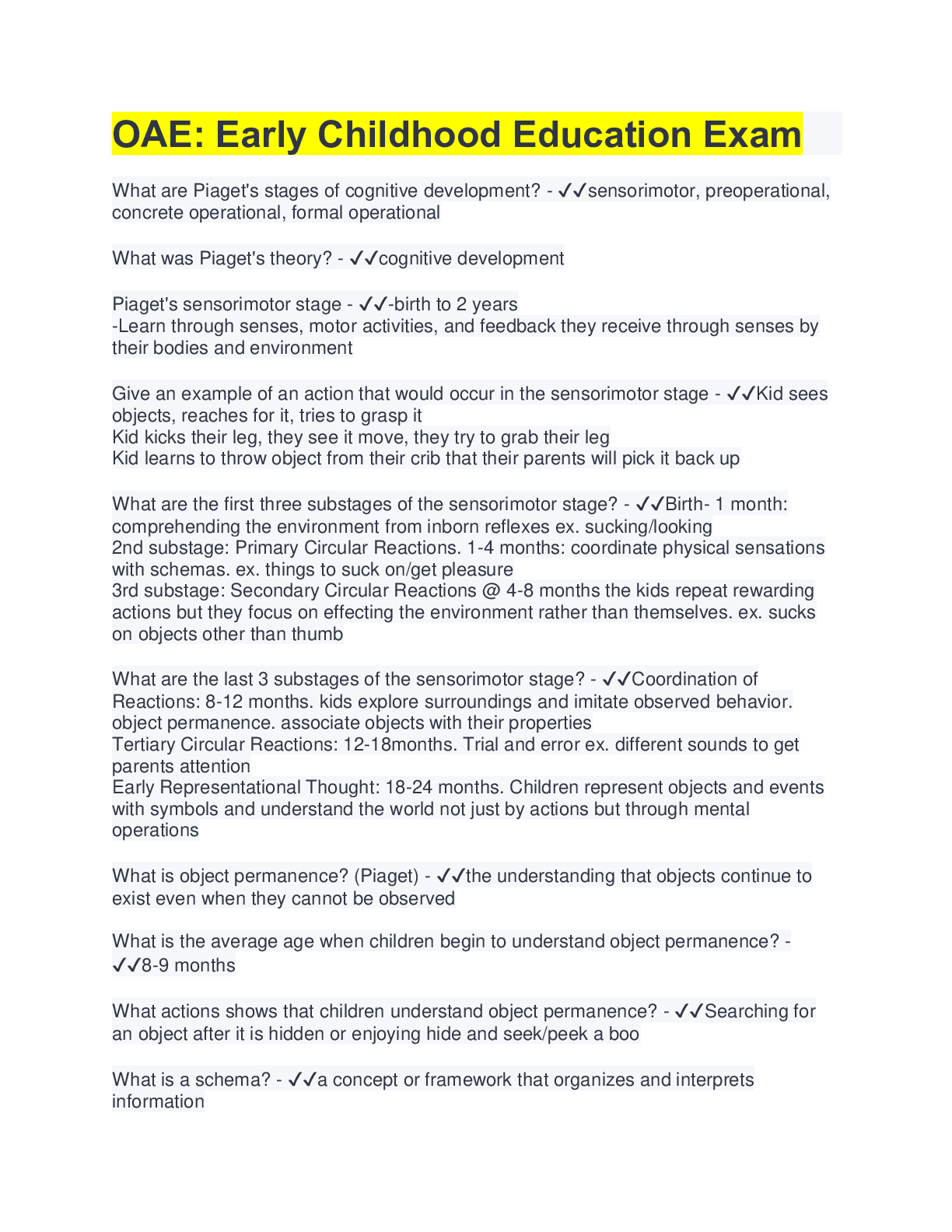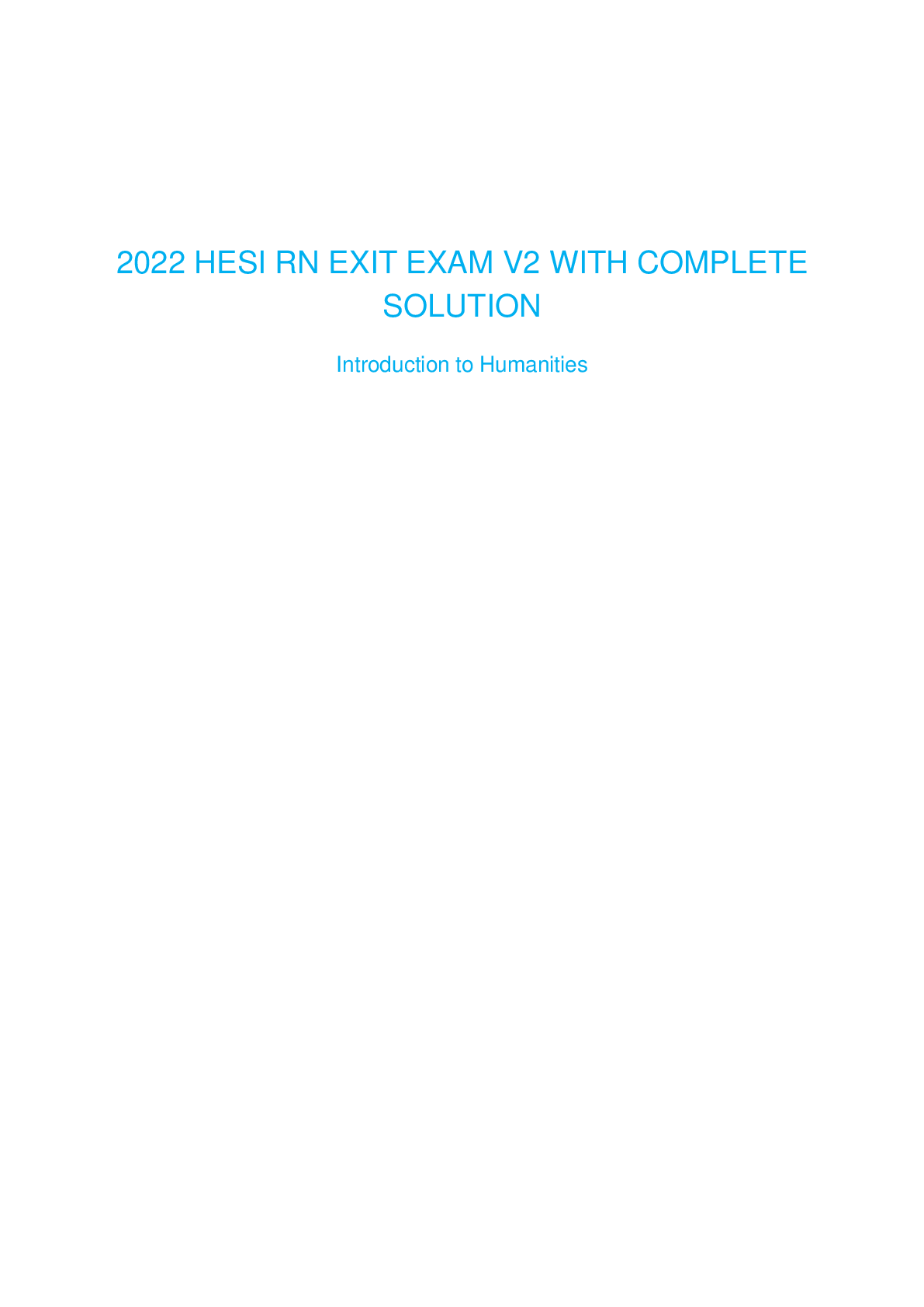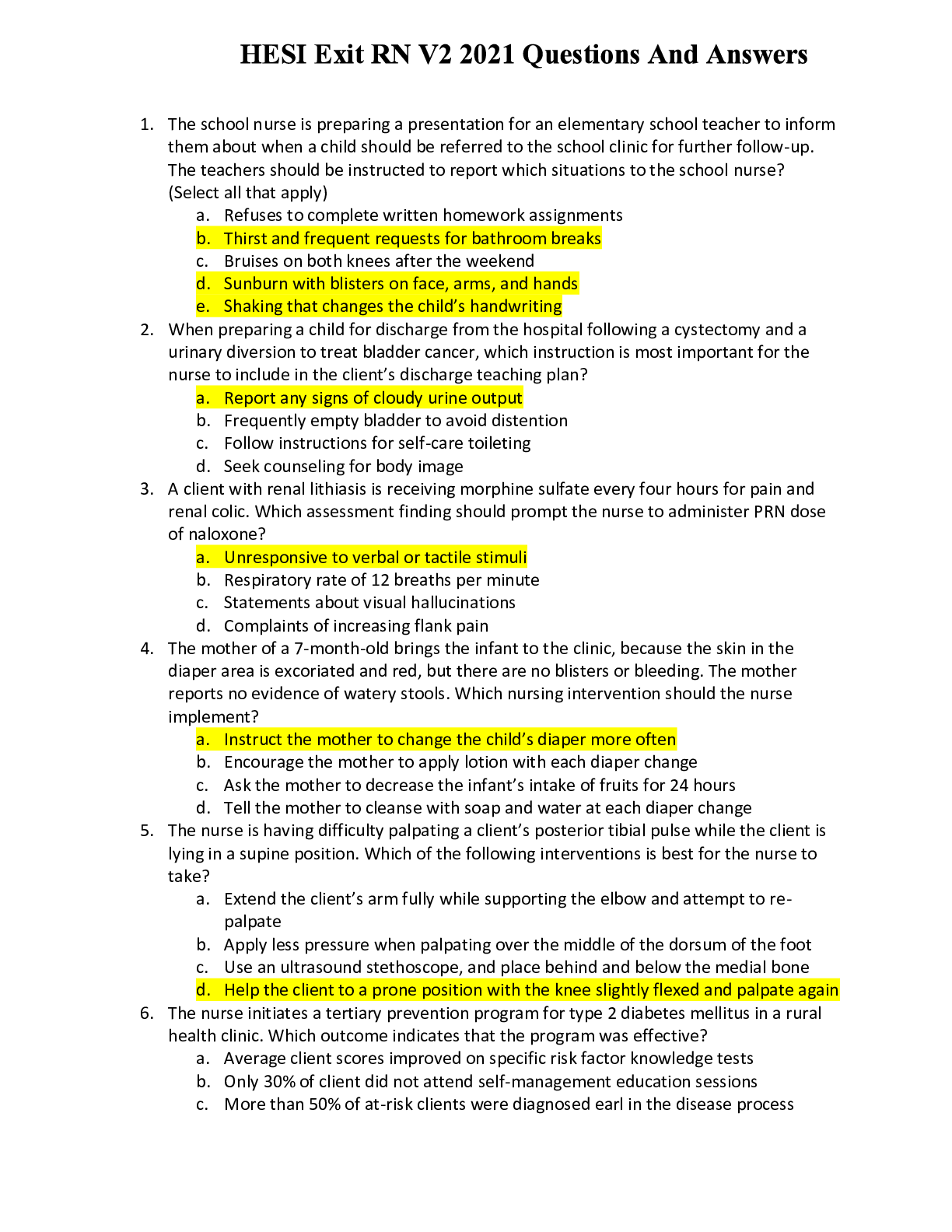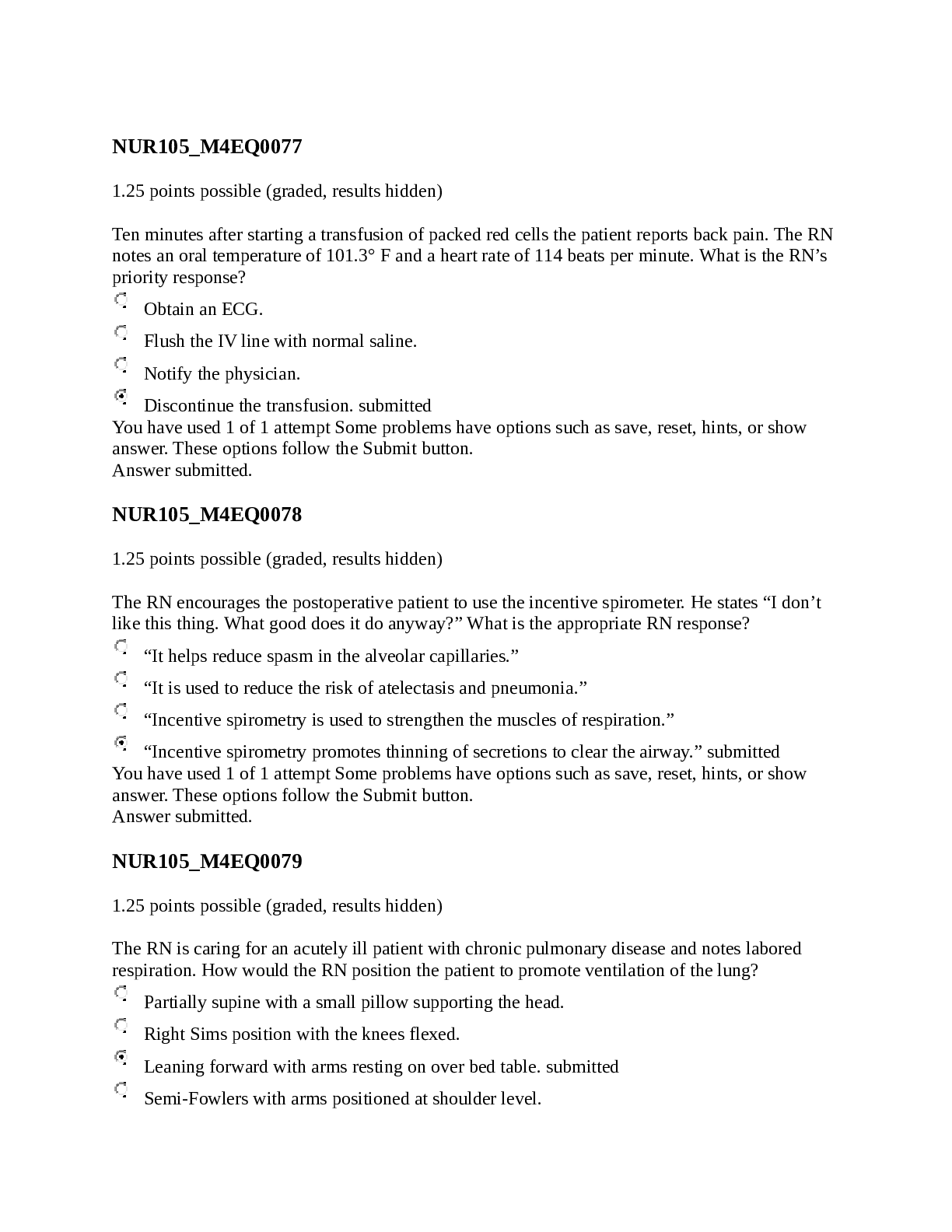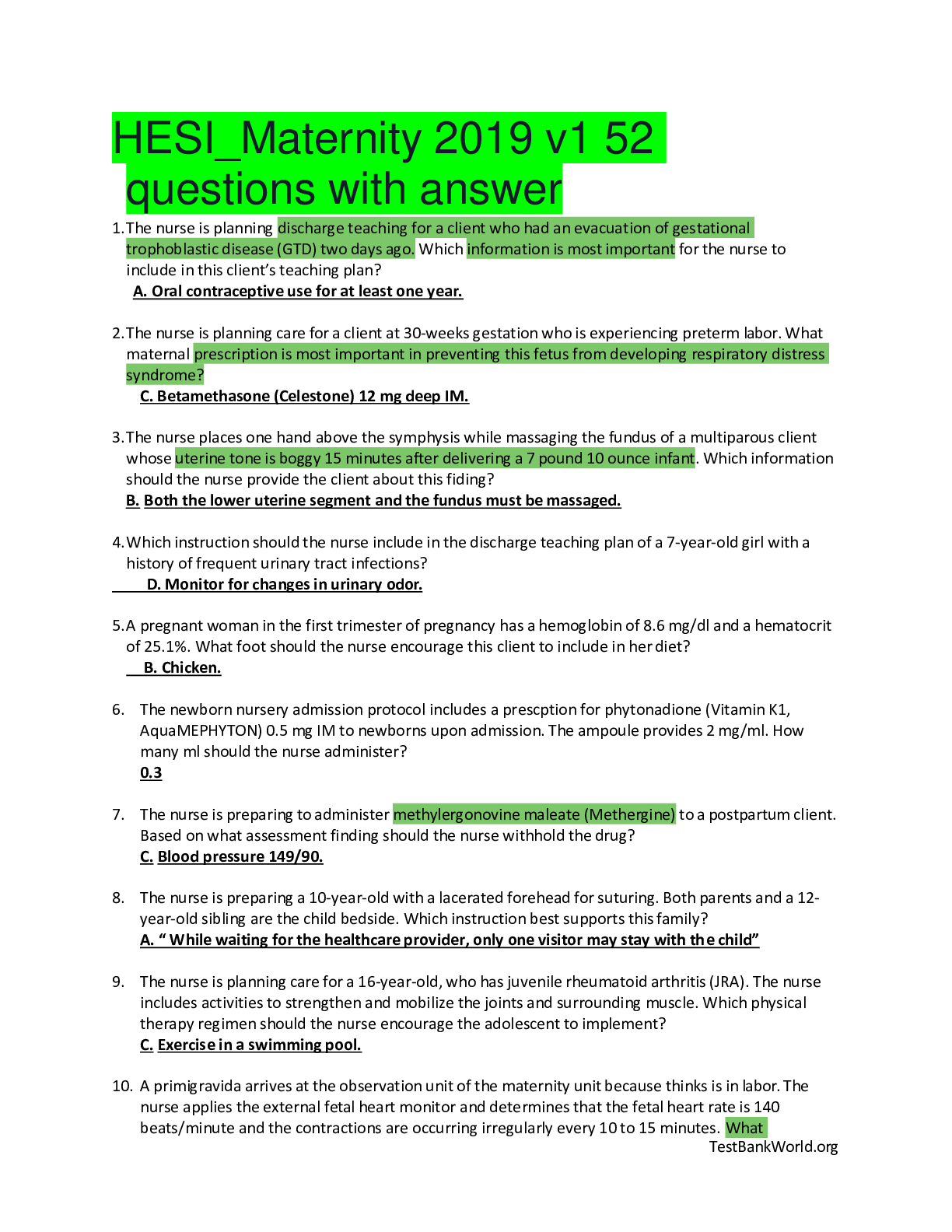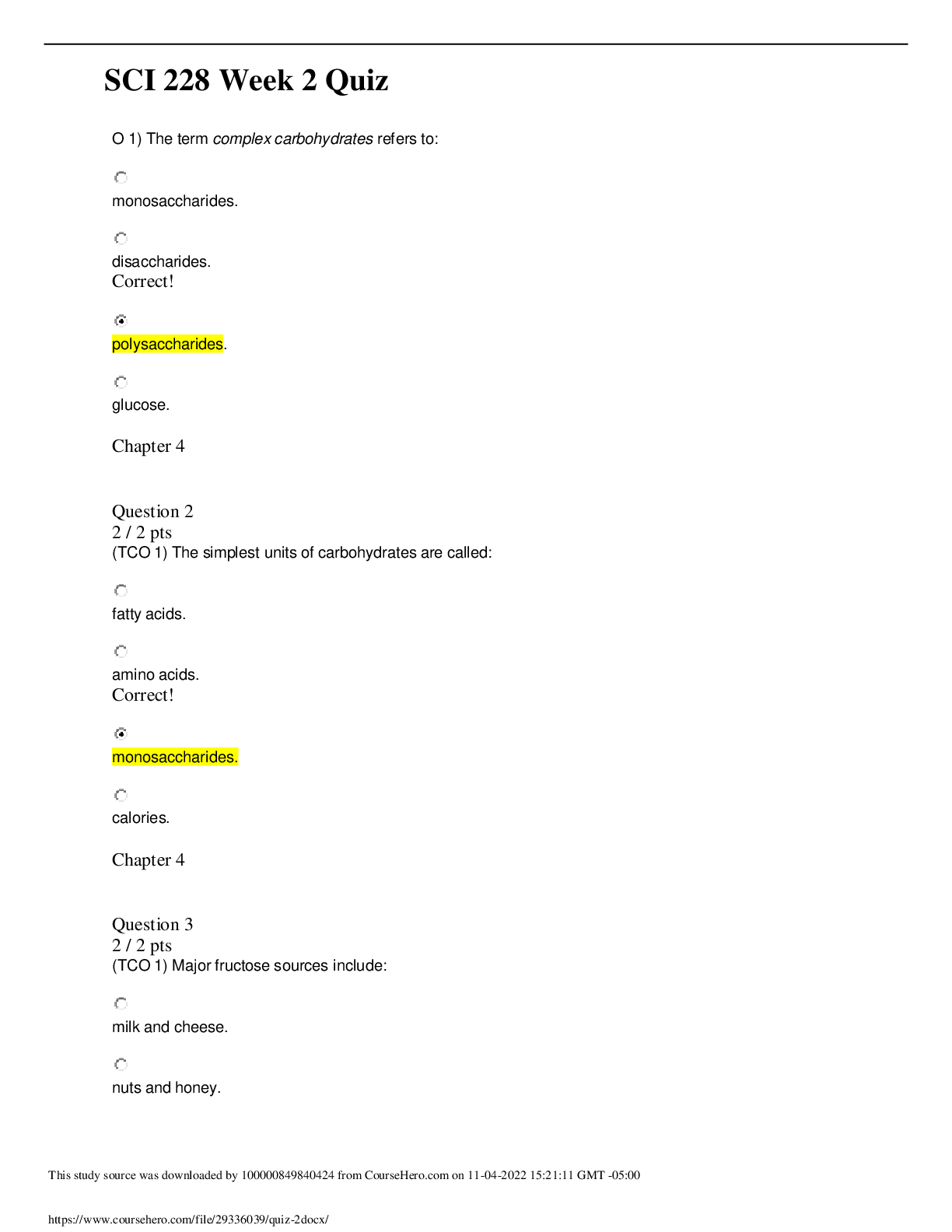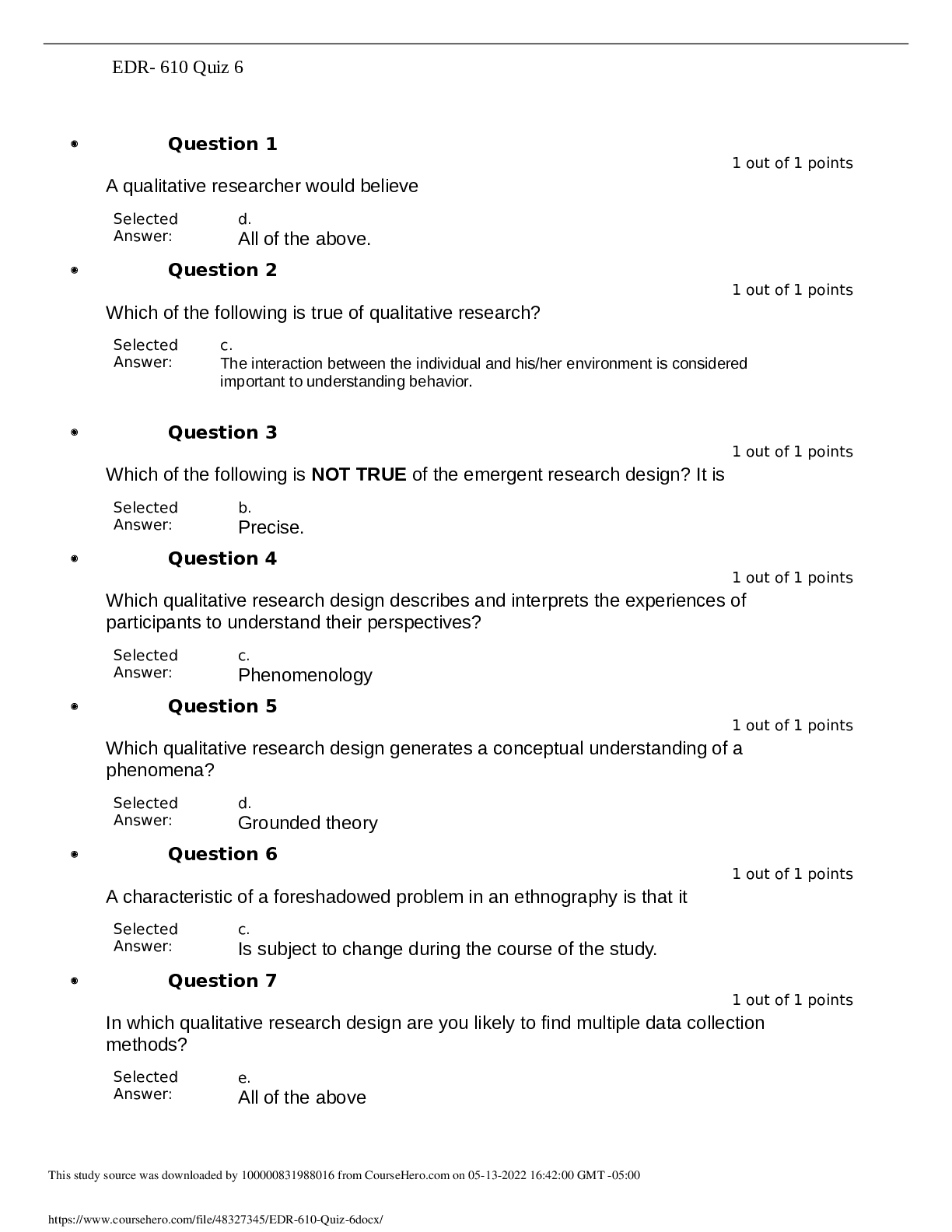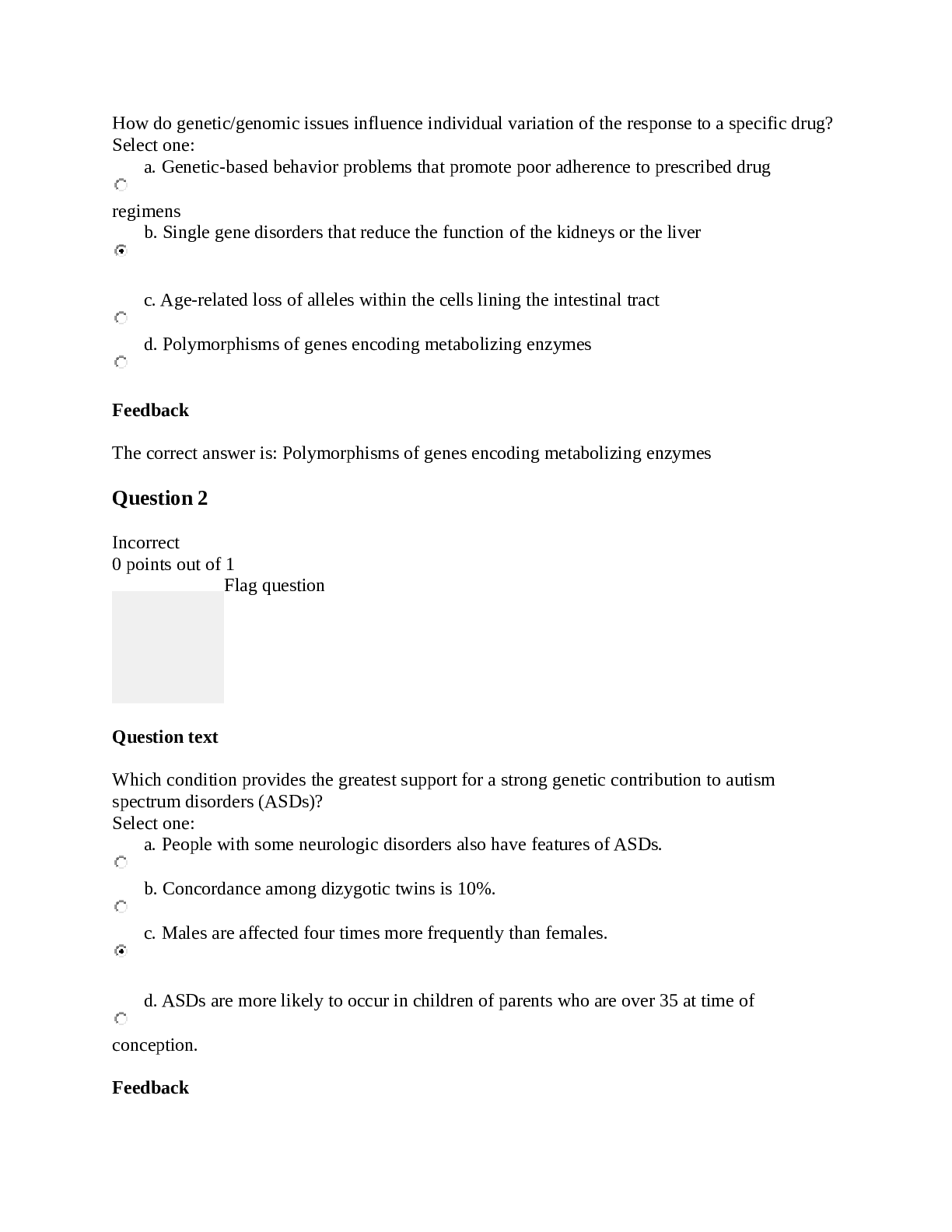Education > EXAM > Intro to Early Childhood Education Exam 160 Questions with Answers,100% CORRECT (All)
Intro to Early Childhood Education Exam 160 Questions with Answers,100% CORRECT
Document Content and Description Below
Intro to Early Childhood Education Exam 160 Questions with Answers Early childhood professional - CORRECT ANSWER An educator who successfully teaches all children, promotes high personal standard... s, and continually expands his or her skills and knowledge. Developmentally appropriate practice - CORRECT ANSWER Tasks that are suitable to a child given his/her age and interests. Developmentally and culturally responsive practice - CORRECT ANSWER teaching based on the ability to respond appropriately to children's and families' developmental, cultural, and ethnic backgrounds and needs Culturally appropriate practice - CORRECT ANSWER application of underlying background knowledge that must be possessed to provide a given client with the best possible health care Antibias education - CORRECT ANSWER an approach that seeks to provide children with an understanding of social and behavioral problems related to prejudice and seeks to provide them with the knowledge, attitude and skills needed to combat prejudice Bias-free - CORRECT ANSWER classroom environment that is free of prejudicial behaviors Healthy environments - CORRECT ANSWER Environments that provide for childrens physical and psychological health, safety, and sense of security, Respectful environments - CORRECT ANSWER A learning environment that shows respect for each individual child and his or her culture, home language, individual abilities or disabilities, family context, and community. Supportive environments - CORRECT ANSWER Environments in which professionals believe each child can learn, and that help children understand and make meaning of their experiences Challenging environments - CORRECT ANSWER A learning environment that provides achievable and stretching experiences for all children. Assessment - CORRECT ANSWER An evaluation technique for technology that requires analyzing benefits and risks, understanding the trade-offs, and then determining the best action to take in order to ensure that the desired positive outcomes outweigh the negative consequences. Responsive relationships - CORRECT ANSWER The relationship that exists between yourself, children, and their families where you are responsive to their needs and interests. Content knowledge - CORRECT ANSWER aids in comprehension, as do practicing reading; and being read to by others, taking what you know about the world to be able to understand Pedagogical content knowledge - CORRECT ANSWER a part ofteachers' professional knowledge that includes the ability to represent abstract concepts in ways that students understand Pedagogical knowledge - CORRECT ANSWER an understanding of how to represent topics in ways that make them understandable to learners, as well as an understanding of what makes specific topics easy or hard to learn Knowledge of learners and learning - CORRECT ANSWER the most important knowledge a teacher can have. interaction with students, more strategic approaches on learning, previous knowledge basis, examples enhancing your knowledge Collaborative planning - CORRECT ANSWER Planning used by groups of teachers at the grade levels, also known as team planning Reflective practice - CORRECT ANSWER Active process of thinking before teaching, during teaching, and after teaching in order to make decisions about how to plan, access, and teach Professional development - CORRECT ANSWER skill and knowledge attained for both personal development and achievement Professional learning community - CORRECT ANSWER A defined group of educational stakeholders brought together to enable teachers and others to collaborate in support of reflective practice action research and ongoing professional development Ethical conduct - CORRECT ANSWER Conduct or behavior which is right or which conforms to the standards of a given society at a given time . . . conduct which is good out of a sense of moral conviction rather than from a fear of punishment. Advocacy - CORRECT ANSWER support; active pleading on behalf of someone or something Professional dispositions - CORRECT ANSWER A term for the values, commitments, and ethical decisions and practices that influence teachers behaviors toward students, families, colleagues and the community members Orbis Pictus - CORRECT ANSWER First picture book published for children, , John Comenius Sensory education - CORRECT ANSWER Learning experiences involving the five senses: seeing, touching, hearing, tasting, and smelling. Blank tablet - CORRECT ANSWER (tabula rasa) in Locke's Essay Concerning the Human Understanding, he likens the brain at birth to a Environmentalism - CORRECT ANSWER A social movement dedicated to protecting the earth's life support systems for us and other species. Emile - CORRECT ANSWER book written by Jean-Jacques Rousseau where he raises a hypothetical child Hierarchy of needs - CORRECT ANSWER Maslow's pyramid of human needs, beginning at the base with physiological needs that must first be satisfied before higher-level safety needs and then psychological needs become active Mesosystem - CORRECT ANSWER In Bronfenbrenner's bioecological approach, interrelationships between microsystems or immediate environments (for example, ways in which events in the family affect a child's interactions at a day care center). Macrosystem - CORRECT ANSWER Consists of cultural values, laws, customs, and resources. Applied behavior analysis - CORRECT ANSWER A systematic approach to teaching based on scientifically demonstrated principles that describe how the environment affects learning. Negative reinforcement - CORRECT ANSWER Increasing behaviors by stopping or reducing negative stimuli, such as shock. A negative reinforcer is any stimulus that, when removed after a response, strengthens the response. (Note: negative reinforcement is not punishment.) positive reinforcement - CORRECT ANSWER Increasing behaviors by presenting positive stimuli, such as food. A positive reinforcer is any stimulus that, when presented after a response, strengthens the response. chronosystem - CORRECT ANSWER In Bronfenbrenner's bioecological approach, the system that captures the way changes in environmental systems, such as social trends and life events, are patterned over a person's lifetime. exosystem - CORRECT ANSWER According to Branfenbrenner, the socioeconomic context that includes institutions of the culture that affect the children's development indirectly. microsystem - CORRECT ANSWER Ecological Theory, immediate environment and face to face interactions, , Family, school, friends, church concrete operations stage - CORRECT ANSWER stage in Piaget's theory characterized by the ability to perform mental operations on physical events only zone of proximal development - CORRECT ANSWER In Vygotsky's theory, the range between children's present level of knowledge and their potential knowledge state if they recieve proper guidance and instruction intersubjectivity - CORRECT ANSWER Mutual, shared understanding among participants in an activity scaffolding - CORRECT ANSWER Adjusting the support offered during a teaching session to fit the child's current level of performance self-talk - CORRECT ANSWER Silent communications with oneself that influence our perceptions of reality preoperational stage - CORRECT ANSWER In Piaget's theory, the stage (from about 2 to 6 or 7 years of age) during which a child learns to use language but does not yet comprehend the mental operations of concrete logic sensorimotor stage - CORRECT ANSWER In Piaget's theory, the stage (from birth to about 2 years of age) during which infants know the world mostly in terms of their sensory impressions and motor activities equilibrium - CORRECT ANSWER A state of balance among the components of a system. accommodation - CORRECT ANSWER According to Piaget, Adapting our current understandings (schemas) to incorporate new information. assimilation - CORRECT ANSWER According to Piaget, the process by which new ideas and experiences are absorbed and incorporated into existing mental structures and behaviors schemes - CORRECT ANSWER In Piaget's theory, actions or mental representations that organize knowledge. adaptation - CORRECT ANSWER Adjustment to environmental conditions active learning theory - CORRECT ANSWER The view that children develop knowledge and learn by being physically and mentally engaged in learning activities constructivism - CORRECT ANSWER A philosophy of learning based on the premise that people construct their own understanding of the world they live in through reflection on experiences. theory - CORRECT ANSWER A hypothesis that has been tested with a significant amount of data learning - CORRECT ANSWER A relatively permanent change in an organism's behavior due to experience. naturalism - CORRECT ANSWER (philosophy) the doctrine that the world can be understood in scientific terms without recourse to spiritual or supernatural explanations unfolding - CORRECT ANSWER coming apart or revealing what will happen next utopian - CORRECT ANSWER (adjective.) having a strong belief that everything can be perfect, often in a way that does not seem to be realistic or practical. kindergarten - CORRECT ANSWER n. a school or class for young children between the ages of four and six years, , a concept that came from Germany; younger children went to schools earlier in life gifts - CORRECT ANSWER Awe and wonder, which are _____, give us the vision to the beauty and sacredness of human life. occupations - CORRECT ANSWER categories of jobs that involve similar activities at different work sites (in a classroom) progressivism - CORRECT ANSWER The movement in the late 1800s to increase democracy in America by curbing the power of the corporation. It fought to end corruption in government and business, and worked to bring equal rights of women and other groups that had been left behind during the industrial revolution. Children's house - CORRECT ANSWER Montessori's first school especially designed to implement her ideas open-air nursery school - CORRECT ANSWER School established by the McMillan sisters; Believed in education where young children could explore their imaginations, develop their sensory and perceptual faculties, and care for gardens and pets. forest schools - CORRECT ANSWER programs with the belief that participating in engaging, motivitating, and achievable tasks and activities in a woodland environment each child has an opportunity to develop intrinsic motivation and sound emotional and social skills child-centered - CORRECT ANSWER teachers provide a variety of activities from which children select, and much learning takes place through play inclusion - CORRECT ANSWER Educating a child with special education needs full-time in the regular classroom. What are the 6 standards of professional development? - CORRECT ANSWER Assessment, Diagnosis, Outcomes Identification, Planning, Implementation, Evaluation What is DAP? - CORRECT ANSWER developmentally appropriate practice What is DCRP? - CORRECT ANSWER Developmentally and culturally responsive practice Antibias curriculum - CORRECT ANSWER approach that seeks to provide children with understanding of social and behavioral problems to prejudice (cultural identity and individual identity) Healthy environment, Respectful environment, Supportive environment, Challenging environment - CORRECT ANSWER The 4 environments that promote child development and learning Know characteristics of families and communities, Become an advocate for parents and families, Support, empower and involve, Respectful of children and families, Diets, home language, child rearing practices, toileting, discipline - CORRECT ANSWER Ways to build and promote family and community relationships The cognitive process of collecting information about children's development, learning, behavior, academic progress, need for special services, and achievements in order to make decisions - CORRECT ANSWER What is the process of assessment? The relationship between yourself, child, and their families where you are responsive to their needs and interests. - CORRECT ANSWER What is a responsive relationship? Content areas - CORRECT ANSWER Language/ literacy, the arts, mathematics, science, physical activity/education, and social studies ethical conduct - CORRECT ANSWER Responsible behavior towards students and parents that allows you to be considered a professional What is advocacy - CORRECT ANSWER The act of engaging in strategies designed to improve the circumstances of children and families. Advocates move beyond their day to day professional responsibilities and work collaboratively to help others. A set of beliefs about how children develop and learn and what/ how they should be taught, Read, Reflect, Discuss, Write, and Evaluate - CORRECT ANSWER What is a philosophy of education? What are the guidelines for developing one? 4 sections of conceptual framework - CORRECT ANSWER Relationships with: children, families, colleagues, and society/ community Ideals - CORRECT ANSWER reflect exemplary professional practice Principles - CORRECT ANSWER describe practices required, prohibited, or permitted Martin Luther - CORRECT ANSWER Translated bible into German, believed family was most important institution in the education of children, believed schools were to teach children to read, believed individuals were free to work out their own salvation through scriptures John Amos Comenius - CORRECT ANSWER The Great Didactic, Orbis Pictus- first picture book, education should begin early and follow the order of nature, sensory education (5 senses) John Locke - CORRECT ANSWER Environmentalism, tabula rosa (blank tablet)- mind is blank when a child is born and is filled with experiences, John-Jacques Rousseau - CORRECT ANSWER wrote the book "Emile", naturalism, sought to create a more family like atmosphere in schools Johann Heinrich Pestalozzi - CORRECT ANSWER started a school called Neuhof where he developed his ideas about integration of home life vocational education and education for reading and writing, education is based on sensory impressions which help children reach their full potential, teachers teach children not subjects, use manipulatives, multiage grouping of children Mary Wollstonecraft - CORRECT ANSWER Paved the way for children to become educators, believed women were capable of rational thought and deserved education Robert Owen - CORRECT ANSWER Utopian, opened the first infant school in London- eventually developed into kindergarten, opened a night school for workers Friedrich Wilhelm Froebel - CORRECT ANSWER developed a curriculum and educational methodology based on gifts occupations songs and games, teacher is responsible for guidance and direction of play so children become creative contributing members of society Henry David Thoreau - CORRECT ANSWER Published "Walden", set foundation for green schools Margarethe Schurz - CORRECT ANSWER Established first Kindergarten in the US in Watertown, Wisconsin Elizabeth Peabody - CORRECT ANSWER Published the Kindergarten guide with her sister, Mary Mann Milton Bradley - CORRECT ANSWER manufactured Frobel's gifts and occupations, helped advance the kindergarten movement, believed toys should have appropriate appearance better learning for children Susan Blow - CORRECT ANSWER Founded the 1st public kindergarten in St. Louis with William T Harris Patty Smith Hill - CORRECT ANSWER thought kindergarten should remain faithful to Frobel's ideas but yet open to innovation, responsible for kindergarten as we know it today McMillan sisters - CORRECT ANSWER Believed in education where children could explore their imaginations develop sensory and perceptual faculties and care for gardens and pets, incorporated environmentalism into their education of young children, opened and open air nursery school Maria Montessori - CORRECT ANSWER First woman in Italy to earn a medical degree, believed that children with mental deficiency was an educational problem not mental John Dewey - CORRECT ANSWER Progressivism, schools should prepare children for the realities of today rather than a vague future time, believed curriculum should be based on children's interests Jean Piaget - CORRECT ANSWER children play an active role in cognitive development Lev Vygotsky - CORRECT ANSWER known for Sociocultural Theory Abraham Maslow - CORRECT ANSWER known for establishing a theory of a hierarchy of needs in which certain lower needs must be satisfied before higher needs can be met Erik Erikson - CORRECT ANSWER Known for his 8-stage theory of Psychosocial Development Howard Gardner - CORRECT ANSWER devised the theory of multiple intelligences (logical-mathematic, spatial, bodily-kinesthetic, intrapersonal, linguistic, musical, interpersonal, naturalistic) Urie Bronfenbrenner - CORRECT ANSWER Said that contextual influences can be categorized into four levels of influence; microsystem, mesosystem, exosystem and macrosystem constuctivism - CORRECT ANSWER based on the proposition that we generate knowledge and meaning from our experiences characteristics of contructivism - CORRECT ANSWER learners construct knowledge that makes sense to them, new learning depends on current understanding, social interaction facilitates learning and meaningful learning occurs within real-world tasks. Piaget's theory of cognitive development - CORRECT ANSWER a comprehensive theory about the nature and development of human intelligence first developed by Jean Piaget. Vygotsky's sociocultural theory - CORRECT ANSWER his ideas presesented as a counterpoint to Piaget's; as if they are in opposing camps; wasn't about 'stages' ;Focused on themes that provide a different perspective on development; Best known for emphasis on critical role that culture or society plays in the transmission of knowledge. Which is why his is called "sociocultural" theory Maslow's self actualization theory - CORRECT ANSWER The whole person is constantly being motivated by one need or another...people have the potential to grow toward psychological health Hierarchy of Needs in order - CORRECT ANSWER Psychological, safety, belonging and love, esteem, cognitive, aesthetic, self-actualization, transcendence Erikson's psychosocial development theory - CORRECT ANSWER trust vs. mistrust, autonomy vs. doubt, initiative vs. guilt, competence vs. inferiority, identity vs. role confusion, intimacy vs. isolation, generativity vs. stagnation, and integrity vs. despair. Gardner's theory of multiple intelligences - CORRECT ANSWER Eight types of intelligence: Linguistic, logical, spatial, kinesthetic, musical, interpersonal, intrapersonal, naturalistic Bronfenbrenner's ecological theory - CORRECT ANSWER focuses on five environmental systems; microsystem, ecosystem, macro system, and chronosystem Absorbent mind - CORRECT ANSWER Montessori's term for a child's ability to absorb experiences from the environment (0-6 years). Prepared environment - CORRECT ANSWER In Montessori education, a classroom with materials well organized and available for children to use with little teacher assistance or intervention. Sensory materials - CORRECT ANSWER Montessori learning materials designed to promote learning through the senses and to train the senses for learning Active learning - CORRECT ANSWER Learning by doing, for example writing, speaking, creating, participating in class plan-do-review - CORRECT ANSWER In a high/scope program, children plan what they will do, do it, and then come back together to review what they did Atelier - CORRECT ANSWER an artist's or a designer's workshop in Reggio-Emilia program center-based child care - CORRECT ANSWER large group program in which child care is provided in a center rather than in a home Synaptogenesis - CORRECT ANSWER Final stage where synapses form - starts before birth but throughout life neurons form new synapses and discard old ones Cephalocaudal development - CORRECT ANSWER the pattern of growth in which areas near the head develop earlier than areas farther from the head Primary circular reactions - CORRECT ANSWER The term Piaget used to describe the infant's tendency to repeat pleasurable bodily actions for their own sake. Symbolic representation - CORRECT ANSWER the use of one object to stand for another Baby signing - CORRECT ANSWER Teaching babies to use signs or gestures to communicate a need or emotion. Motherese - CORRECT ANSWER Modifications in adults' speech to infants; baby talk Bonding - CORRECT ANSWER Close physical and emotional contact between parent and child immediately following birth. Early intervention - CORRECT ANSWER Programs that target at-risk infants and toddlers to prevent possible later need for remediation. Infant/toddler mental health - CORRECT ANSWER The overall health and well-being of young children in the context of family, school, and community relationships. self-regulation - CORRECT ANSWER Children's ability to conform to parental standards of behavior without direct supervision, mid childhood, varies on expectations/gender, authoritative parents impulse control - CORRECT ANSWER the ability to wait and think before acting or speaking Informal (free) play - CORRECT ANSWER play in which children play in activities of interest to them. modes of response - CORRECT ANSWER the various ways children respond to books and converstions Phonological awareness - CORRECT ANSWER Includes ability of a student to identify & manipulate large parts of spoken language & awareness of other aspects of sound in language. Examples: alliteration, intonation, rhyming. Discourse skills - CORRECT ANSWER Activities that encourage telling stories and explaining how the world works. vocabulary knowledge - CORRECT ANSWER the ability to use a given known word productively or to recognize it passively transition - CORRECT ANSWER A change from one activity, condition, or location to another phonological memory - CORRECT ANSWER the ability to remember spoken information for a short period of time Conventional literacy skills - CORRECT ANSWER kind of reading and writing that is taught in elementary school Emergent literacy - CORRECT ANSWER K-1st Understanding of letter forms and names, understand concepts of print and increased literacy. socio-dramatic play - CORRECT ANSWER social play in which several children play togerher as the imitate others social play - CORRECT ANSWER play that involves social interactions with peers Operation - CORRECT ANSWER A statement that describes how to measure a variable or define a term. Autonomy - CORRECT ANSWER Childhood process of becoming independent. temperament - CORRECT ANSWER An child's behavioral style and characteristic way of responding. attachment - CORRECT ANSWER An emotional tie with another person; shown in young children by their seeking closeness to the caregiver and showing distress on separation. telegraphic speech - CORRECT ANSWER early speech stage in which a child speaks like a telegram--'go car'--using mostly nouns and verbs and omitting 'auxiliary' words holophrases - CORRECT ANSWER One-word sentences commonly used by children under 2 years of age symbolic play - CORRECT ANSWER Play in which one object stands for or represents another (2-4 years) tertiary circular reactions - CORRECT ANSWER The deliberate experimentation with various actions that occurs in substage 5 of the sensorimotor period. secondary circular reactions - CORRECT ANSWER begin to understand social interactions: *Object permanence: making meaning out of their experiences proximodistal development - CORRECT ANSWER Development that occurs from the core or center of the body outwards (towards the extremities) sensitive periods - CORRECT ANSWER Time periods when specific skills develop most easily neural shearing - CORRECT ANSWER the process of brain connections withering away when they are used only a little or not at all is called: Family child care - CORRECT ANSWER An arrangement in which an individual uses his/her own home as a place to provide care for other people's children atelierista - CORRECT ANSWER In Reggio schools, an art director who helps teachers and children express their interest and knowledge in many different media auto-education - CORRECT ANSWER The idea that children teach themselves through appropriate materials and activities practical life - CORRECT ANSWER Montessori activities that teach skills related to everyday living. Key developmental indicators - CORRECT ANSWER In the HighScope approach, activities that foster developmentally important skills and abilities Object permanence - CORRECT ANSWER The awareness that things continue to exist even when not perceived Fantasy play - CORRECT ANSWER Play that involves making up and acting out a scenario; also called pretend play. [Show More]
Last updated: 1 year ago
Preview 1 out of 16 pages
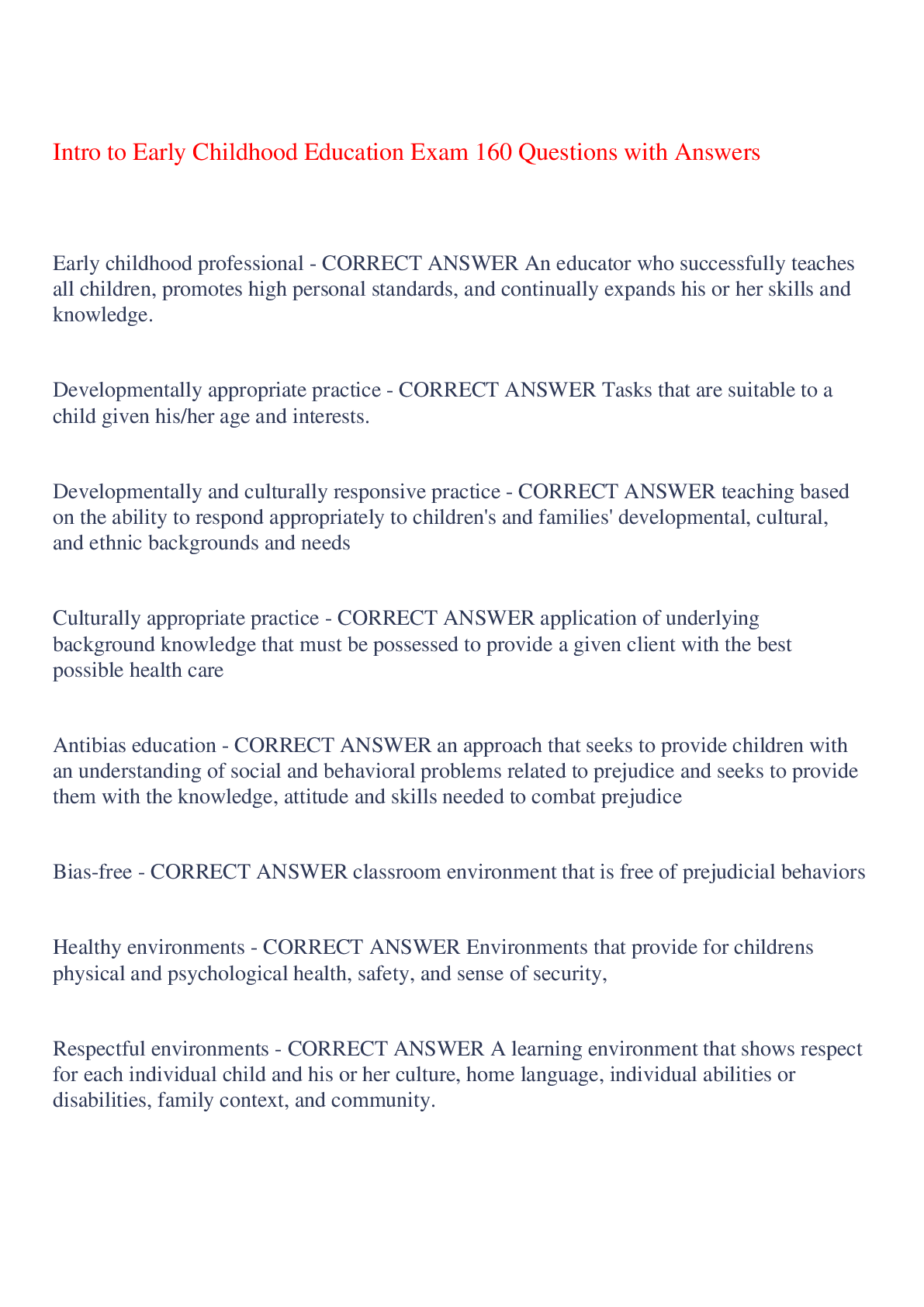
Reviews( 0 )
Document information
Connected school, study & course
About the document
Uploaded On
Apr 29, 2023
Number of pages
16
Written in
Additional information
This document has been written for:
Uploaded
Apr 29, 2023
Downloads
0
Views
66





